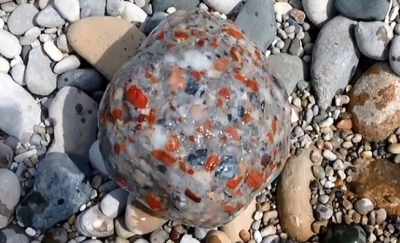
|
A mixture of different-sized pebbles cemented by sand, formed in river channels over thousands of years. It looks a bit like a Christmas pudding. |
Puddingstone is a nonscientific name for a conglomerate in which subrounded to rounded pebbles occur in a matrix of sharply contrasting color.
The name “puddingstone” was first used in Great Britain where the rocks were said to “look like a plum pudding”. A well-known example is the Hertfordshire Puddingstone, from the lower Eocene of the London Basin. It consists of colorful flint pebbles in a white to brown silicate matrix. It is a rock found at many locations in Hertfordshire County, England.
Puddingstones immediately catch the eye of the geologist and the eyes of people who otherwise have no special interest in rocks. People have an immediate interest in the rocks and carry them home from beaches, streams, and wherever they are found.
Many particularly nice specimens find a place on desks, bookshelves, window sills and other locations where they will be seen by and delight even more people. Their popularity greatly exceeds their abundance.
Credit: Geology.com
Picture credit: Google




